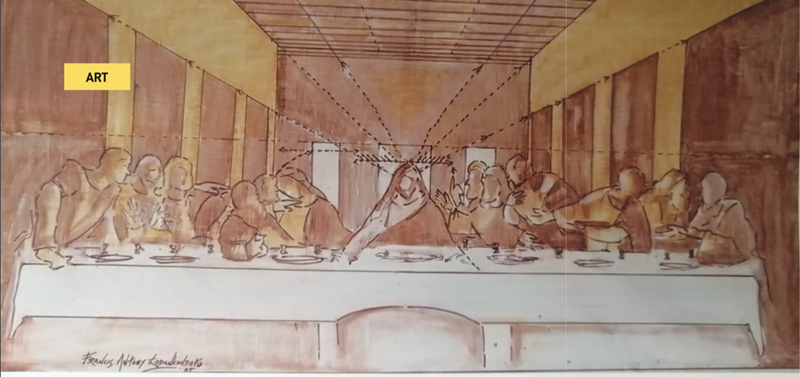Is there a red tape when it comes to artistic expression and analysis in a religious context, or have we fully embraced the autotelism of art?
SUSANNA CORREYA
The stripped down paintings of Francis Kodankandath contrast the opulence and the essence of the Church. His jarring juxtapositions invite us to ponder whether our eyes are trained on the materiality or the essence of Christianity. They hover between completeness and incompleteness to remind the viewers that the Church is still a work in progress while prompting us to reexamine the foundation upon which it was built and conclude that, maybe, we have thrust a grand façade upon a humble scaffolding.
Often, the plain message of scriptural logos is obscured and lost in the dense jungle of interpretation, vitiated by conflicting exegeses whose stylistics excel their substance. When this ornate impasto flakes, perhaps we will glimpse and excavate the original truth. While the artworks are not a denunciation of interpretation, they seem to vouch for an appraisal of the robustness and the aptness of the framework whence they will proceed.
Art is all about perspective. The unconcealed linear perspective and the undefined physiognomy of the disciples in Decoding Davinci reinforces the centrality of Christ. The ambiguous character in Leonardo da Vinci’s The Last Supper instigated speculation that troubled the legacy of Mary Magdalene and Christ. Kodankandath attempts to rectify this deflection by returning the focus to Christ and the Eucharistic meal.
Now, a question remains: Is there a red tape when it comes to artistic expression and analysis in a religious context, or have we fully embraced the autotelism of art? Under the logic and discourse of autotelism, art need not service a moral or religious agenda. Bring “art for art’s sake” to converse with Barthes’ “death of the author” and the esthetic value of art could triumph over its religious value while myriad interpretive possibilities flourish.
The affective possibilities of beauty are vast and varied. The sublime majesty of a church can lure you into its portals. Hopefully, you won’t need perspective lines to identify the heart of the place.
∎